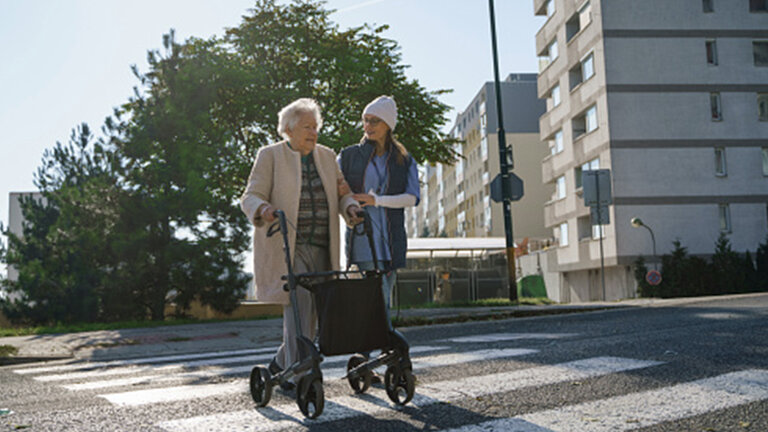Accessible town planning

The UrbanLife+ project aimed to make senior citizens safer and give them more independence in their neighborhood. Drees & Sommer development managers supported the project from its launch in 2015 to its successful conclusion five years later. The results are summarized in the Safety Atlas, which is a reference work for cities, municipalities, and urban planning offices.
What does quality of life look like for senior citizens?
Making the city a place where everyone will feel at home in the future is perhaps wishful thinking in light of the high curbs and poorly lit paths. Those with difficulty walking, seeing, and hearing often have a hard time in urban environments. In order to maintain a high quality of life for senior citizens, cities and municipalities must ensure that people can actively participate in public life in old age instead of retreating into their own four walls. The prerequisite for this is that they must be able to move around safely in their city or at least in their neighborhood.
What was the approach of the funded research project?
The UrbanLife+ research project, which received €6.2 million in funding from the Federal Ministry of Education and Research, addressed the issue of an age-appropriate city. To this end, the participants developed and tested technical possibilities in two pilot neighborhoods in Mönchengladbach: the urban Hardterbroich-Pesch and the more rural Rheindahlen.
A team of Drees & Sommer development managers led by Mustafa Kösebay and Fabian Gierl were among the 11 UrbanLife+ partners involved in the research project for the entire duration of the project from 2015 to the end of October 2020.
How can barriers in urban areas be broken down?
The partners involved in the project needed a lot of data to develop assistance systems and remove potential barriers. They needed to know where exactly the urban properties were located, what features they had, and whether they could be technically equipped.
The Drees & Sommer project team collected the geodata and other information on benches, curbs, street lamps, bus stops, sidewalks, and traffic lights by carrying out inspections and using a surveying vehicle.
Human-computer interaction reduces barriers
The core questions were what can be done to make life easier for older people in public spaces and how human-technology interaction or human-computer interaction can support this.
This refers to the interplay between people and technical systems in general and user-friendly interactive systems based on computer technology in particular. Both fields are interdisciplinary as experts from various disciplines, such as computer science, psychology and design, work together.
How can smart solutions be integrated into urban planning?
Over the course of the project, many different innovative ideas came together, such as the sitting flower, which unfolds from the ground to form a seat when needed. It is a foldable and therefore space-saving seat for outside walls or a device for wheelchair-accessible urban gardening, so there is a good chance of it really catching on.
Fabian Gierl from Drees & Sommer would have liked to have realized even more pioneering prototypes. However, due to the IT focus of the students involved in the project, the emphasis was on sensors. For example, the students developed a large touchscreen—called an info spotlight—that provides residents of a retirement home with information about their neighborhood.
Sat nav guides you safely to the toilet
Other options include adaptive street lighting that adjusts to the eyesight of passers-by so that they can easily find their way around even in the dark. A navigation system guides them to the nearest bakery or public toilet. It avoids typical tripping hazards such as high curbs, surfaces unsuitable for walking frames, or steep inclines.
What was the outcome of the project?
The five-year project resulted in the creation of the so-called Safety Atlas. This was published in 2021 under the title “Stadt der Zukunft – Smartes Stadtmobiliar für mehr Teilhabe im Alter” (City of the Future—Smart Street Furniture for Greater Participation in Old Age) by medhochzwei. Mustafa Kösebay is one of the editors of the reference work, which is intended to serve as a guide to action for cities, municipalities, and urban planning offices.
Whether it’s a bus stop, a traffic light crossing, or an entire neighborhood, those responsible can benefit from the experience gained from UrbanLife+ and be inspired by concrete measures and ideas for future development projects.
Ageing society: trend of generation-orientated urban development
A look at the age statistics shows that UrbanLife+ has addressed a highly relevant social topic. According to United Nations estimates, more than 23 percent of Europeans will be aged 65 or over by 2030. At the same time, 60 percent of people worldwide will be living in cities by this time.
The article has been revised // Original contribution from March 2020

